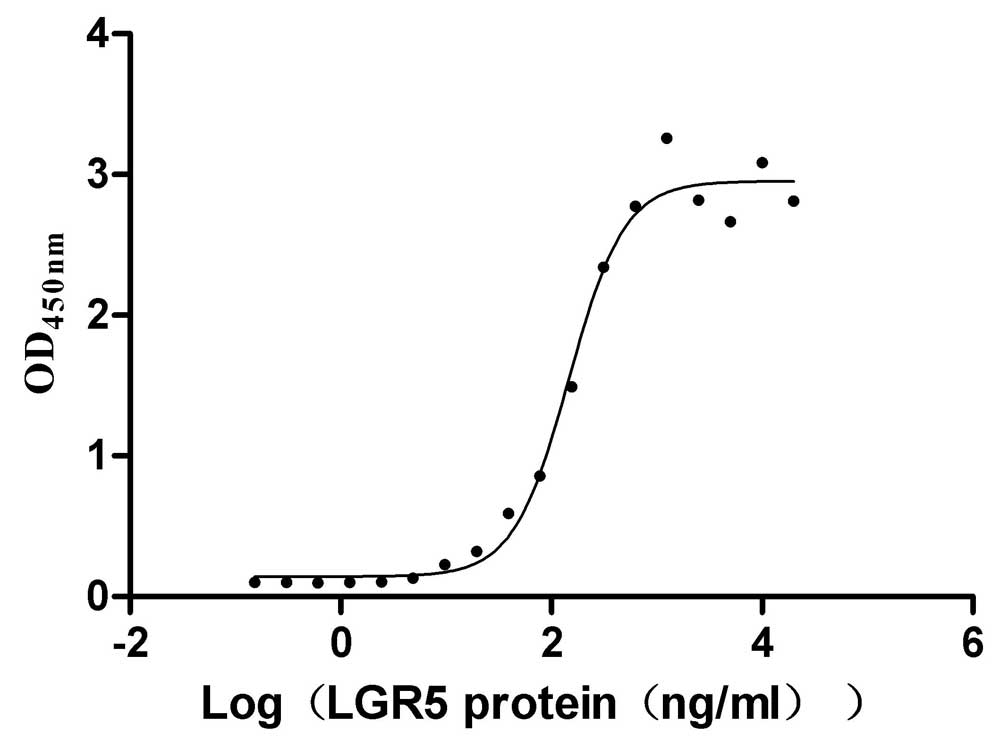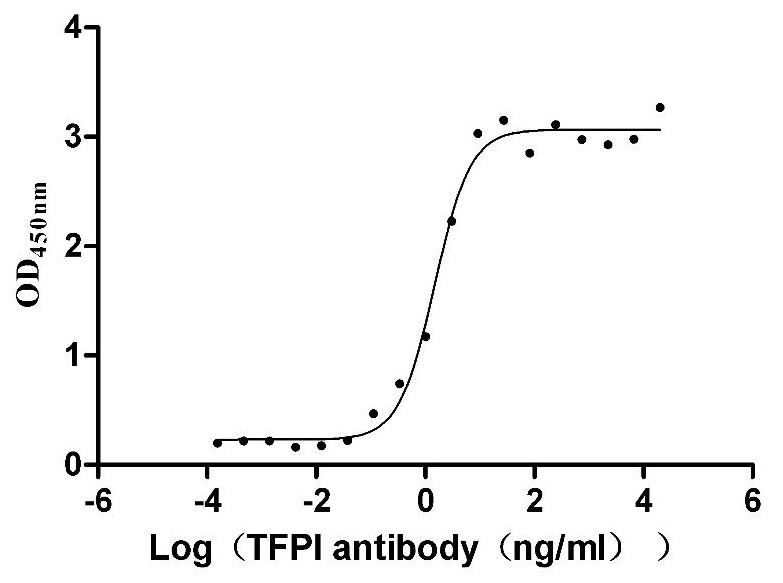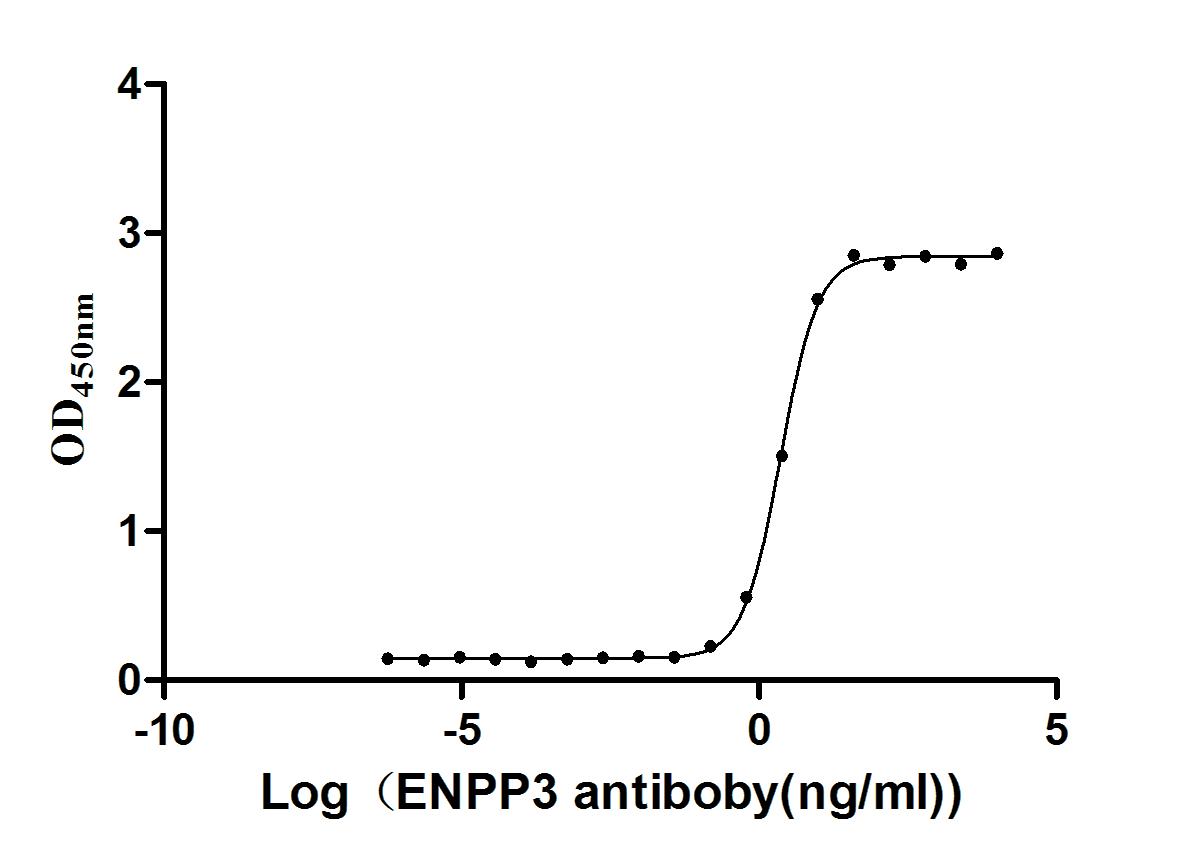Recombinant Mouse Lymphocyte activation gene 3 protein (Lag3), partial
-
中文名稱(chēng):小鼠Lag3重組蛋白
-
貨號(hào):CSB-YP720261MO
-
規(guī)格:
-
來(lái)源:Yeast
-
其他:
-
中文名稱(chēng):小鼠Lag3重組蛋白
-
貨號(hào):CSB-EP720261MO
-
規(guī)格:
-
來(lái)源:E.coli
-
其他:
-
中文名稱(chēng):小鼠Lag3重組蛋白
-
貨號(hào):CSB-EP720261MO-B
-
規(guī)格:
-
來(lái)源:E.coli
-
共軛:Avi-tag Biotinylated
E. coli biotin ligase (BirA) is highly specific in covalently attaching biotin to the 15 amino acid AviTag peptide. This recombinant protein was biotinylated in vivo by AviTag-BirA technology, which method is BriA catalyzes amide linkage between the biotin and the specific lysine of the AviTag.
-
其他:
-
中文名稱(chēng):小鼠Lag3重組蛋白
-
貨號(hào):CSB-BP720261MO
-
規(guī)格:
-
來(lái)源:Baculovirus
-
其他:
產(chǎn)品詳情
-
純度:>85% (SDS-PAGE)
-
基因名:Lag3
-
Uniprot No.:
-
別名:Lag3; Lymphocyte activation gene 3 protein; LAG-3; Activation-induced cytidine deaminase-linked autoimmunity protein; Aida; CD antigen CD223) [Cleaved into: Secreted lymphocyte activation gene 3 protein; sLAG-3)]
-
種屬:Mus musculus (Mouse)
-
蛋白長(zhǎng)度:Partial
-
蛋白標(biāo)簽:Tag?type?will?be?determined?during?the?manufacturing?process.
The tag type will be determined during production process. If you have specified tag type, please tell us and we will develop the specified tag preferentially. -
產(chǎn)品提供形式:Lyophilized powder
Note: We will preferentially ship the format that we have in stock, however, if you have any special requirement for the format, please remark your requirement when placing the order, we will prepare according to your demand. -
復(fù)溶:We recommend that this vial be briefly centrifuged prior to opening to bring the contents to the bottom. Please reconstitute protein in deionized sterile water to a concentration of 0.1-1.0 mg/mL.We recommend to add 5-50% of glycerol (final concentration) and aliquot for long-term storage at -20℃/-80℃. Our default final concentration of glycerol is 50%. Customers could use it as reference.
-
儲(chǔ)存條件:Store at -20°C/-80°C upon receipt, aliquoting is necessary for mutiple use. Avoid repeated freeze-thaw cycles.
-
保質(zhì)期:The shelf life is related to many factors, storage state, buffer ingredients, storage temperature and the stability of the protein itself.
Generally, the shelf life of liquid form is 6 months at -20°C/-80°C. The shelf life of lyophilized form is 12 months at -20°C/-80°C. -
貨期:Delivery time may differ from different purchasing way or location, please kindly consult your local distributors for specific delivery time.Note: All of our proteins are default shipped with normal blue ice packs, if you request to ship with dry ice, please communicate with us in advance and extra fees will be charged.
-
注意事項(xiàng):Repeated freezing and thawing is not recommended. Store working aliquots at 4°C for up to one week.
-
Datasheet :Please contact us to get it.
相關(guān)產(chǎn)品
靶點(diǎn)詳情
-
功能:Lymphocyte activation gene 3 protein: Inhibitory receptor on antigen activated T-cells. Delivers inhibitory signals upon binding to ligands, such as FGL1. FGL1 constitutes a major ligand of LAG3 and is responsible for LAG3 T-cell inhibitory function. Following TCR engagement, LAG3 associates with CD3-TCR in the immunological synapse and directly inhibits T-cell activation. May inhibit antigen-specific T-cell activation in synergy with PDCD1/PD-1, possibly by acting as a coreceptor for PDCD1/PD-1. Negatively regulates the proliferation, activation, effector function and homeostasis of both CD8(+) and CD4(+) T-cells. Also mediates immune tolerance: constitutively expressed on a subset of regulatory T-cells (Tregs) and contributes to their suppressive function. Also acts as a negative regulator of plasmacytoid dendritic cell (pDCs) activation. Binds MHC class II (MHC-II); the precise role of MHC-II-binding is however unclear.; May function as a ligand for MHC class II (MHC-II) on antigen-presenting cells (APC), promoting APC activation/maturation and driving Th1 immune response.
-
基因功能參考文獻(xiàn):
- upregulated in the central nervous system by intraepithelial lymphocytes from the gut epithelium of myelin oligodendrocyte glycoprotein(35-55)-specific T-cell receptor transgenic mice PMID: 27198196
- thi study shows that LAG-3 directly modulates the size of the T cell response and support the use of LAG-3 blockade regimens to enhance CD8+ T cell responses PMID: 27206765
- Study suggests that expression of the inhibitory receptors PD-1 and LAG-3 on CD4(+) T cells and their reduced IL-2 production are common characteristic features of Plasmodium infection. PMID: 26696540
- An IL-27/Lag3 axis enhances Foxp3+ regulatory T cell-suppressive function and therapeutic efficacy. PMID: 26013006
- LAG3 and PD1 co-inhibitory molecules have roles in collaborating to limit CD8+ T cell signaling and dampen antitumor immunity in a murine ovarian cancer model PMID: 26318293
- Poxvirus-Based Active Immunotherapy with PD-1 and LAG-3 Dual Immune Checkpoint Inhibition Overcomes Compensatory Immune Regulation, Yielding Complete Tumor Regression in Mice. PMID: 26910562
- Lymphatic endothelial cells (LECs) serve as an antigen reservoir for CD4 T-cell tolerance, and MHC-II molecules on LECs are used to induce CD8 T-cell tolerance via LAG-3. PMID: 25857745
- LAG-3 expression on Tconv cells makes them more susceptible to Treg based suppression, and also regulates the development of a TH1 T-cell response. PMID: 25372844
- LAG-3 exerts an important regulatory effect on autoimmunity. PMID: 25122007
- Lag-3 is an important regulatory molecule involved in alloreactive T cell proliferation and activation after bone marrow transplantation. PMID: 24475140
- these results define a strong synergy between the PD-1 and LAG-3 inhibitory pathways in tolerance to both self and tumor antigens. PMID: 22186141
- We conclude that LAG-3 is necessary for regulating CD4(+) and CD8(+) T cell function during autoimmune diabetes PMID: 21873518
- LAG-3 is required for long-term peripheral CD8 but not CD4 T-cell tolerance and this requirement is CD8 cell-extrinsic. PMID: 21422469
- LAG-3 acts synergistically with PD-1 and/or other immunoregulatory genes to prevent autoimmunity in mice. PMID: 21300912
- This significant intracellular storage of LAG-3 appears to facilitate its rapid translocation to the cell surface following T-cell activation, which was much faster for LAG-3 than CD4 PMID: 20391435
- blockade of LAG-3 did not rescue cytokine production by virus-specific CD8 T cells and did not alter the virus titer in various organs PMID: 19880580
- Lag3 inhibits CD4-dependent, but not CD4-independent, T cell function via its cytoplasmic domain. PMID: 12421911
- LAG-3 regulates the expansion of activated T cells. PMID: 12672063
- LAG-3 activates antigen-presenting cells through MHC class II signalling, leading to increased antigen-specific T-cell responses in vivo. PMID: 14644131
- data suggest that LAG-3 negatively regulates T cell expansion and controls the size of the memory T cell pool PMID: 15100286
- LAG-3 marks regulatory T cell populations and contributes to their suppressor activity PMID: 15485628
- LAG-3 is cleaved within the D4 transmembrane domain connecting peptide into two fragments that remain membrane associated. Modulation of LAG-3 cleavage may contribute to the function of this key regulatory T cell protein. PMID: 15557174
- LAG-3 negatively regulates T cell homeostasis by regulatory T cell-dependent and independent mechanisms. PMID: 15634887
- LAG-3 is a new marker of T cell induced B cell activation. PMID: 15971272
- Metalloprotease-mediated cleavage of LAG-3 controls T-cell proliferation and immune response. PMID: 17245433
- Data demonstrate a direct role for LAG-3 on CD8+ T cells and suggest that LAG-3 blockade may be a potential cancer treatment. PMID: 17932562
- a novel ITAM-mediated inhibitory signaling pathway in DCs triggered by MHC II engagement of LAG-3, providing a molecular mechanism in which regulatory T cells may suppress via modulating DC function. PMID: 18424711
- LAG-3 plays an important but selective cell intrinsic and cell extrinsic role in plasmacytoid dendritic cells biology PMID: 19201841
- signaling through the PD-1 and LAG-3 pathways have distinct functional consequences to CD8 T cells under tolerizing conditions PMID: 19454660
顯示更多
收起更多
-
亞細(xì)胞定位:[Lymphocyte activation gene 3 protein]: Cell membrane; Single-pass type I membrane protein.; [Secreted lymphocyte activation gene 3 protein]: Secreted.
-
組織特異性:Primarily expressed in activated CD4(+) and CD8(+) T-cells. Also expressed in a subset of regulatory T-cells (Tregs), such as natural CD4(+)CD25(+) Tregs. Also expressed on plasmacytoid dendritic cells (pDCs).
-
數(shù)據(jù)庫(kù)鏈接:
Most popular with customers
-
Recombinant Human Prolactin receptor (PRLR), partial (Active)
Express system: Mammalian cell
Species: Homo sapiens (Human)
-
Recombinant Human Claudin-18.2 (CLDN18.2)-VLPs (Active)
Express system: Mammalian cell
Species: Homo sapiens (Human)
-
Recombinant Macaca mulatta Microtubule-associated protein tau (MAPT) (Active)
Express system: Mammalian cell
Species: Macaca mulatta (Rhesus macaque)
-
Recombinant Mouse Microtubule-associated protein tau (Mapt) (Active)
Express system: Mammalian cell
Species: Mus musculus (Mouse)
-
Recombinant Human R-spondin-1 (RSPO1), partial (Active)
Express system: Mammalian cell
Species: Homo sapiens (Human)
-
Recombinant Human Tissue factor pathway inhibitor (TFPI), partial (Active)
Express system: Mammalian cell
Species: Homo sapiens (Human)
-
Express system: Mammalian cell
Species: Homo sapiens (Human)
-
Recombinant Macaca fascicularis lymphocyte antigen 6 family member G6D (LY6G6D) (Active)
Express system: Yeast
Species: Macaca fascicularis (Crab-eating macaque) (Cynomolgus monkey)



-AC1.jpg)
















